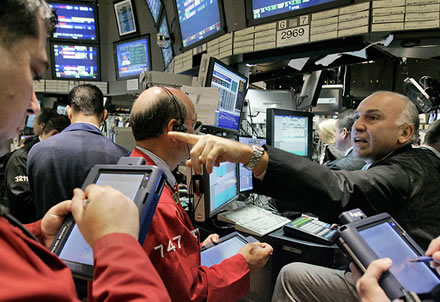Posted September 29, 2008
by Charlie Post
IS THE BANKING crisis the end of capitalism as we know it?

Put simply, the answer is no. Capitalism cannot avoid periodic short-term and long-term crises of falling profits and economic stagnation. However, as Marx pointed out over one hundred fifty years ago, capitalism has internal mechanisms—driving down wages, reorganizing work, massive bankruptcies—that allow it to recover from these crises. There will be no “final” economic crisis of capitalism—it will have to be overthrown.
What do we make of the current financial meltdown? Clearly the collapse of the subprime mortgage market was the immediate trigger for the crisis, although, as Doug Henwood has pointed out, subprime mortgages make up at most about one quarter of the mortgage market, and only 10%-15% of these loans are at risk of default. The deregulation of the financial sector — begun under Reagan and the first Bush, and completed under Clinton — has led to the mushrooming of financial derivatives (hedge funds, mortgage-backed bonds, etc.) with little foundation in real capital invested in buildings, machinery, equipment and stocks of goods and services (the “real economy”).

A Brief To-Do List for the Next President’s First Day…
–The Financial Calamity, Blacks and Obama be Malik Miah
–Socialists and Barack Obama: Viewing An Historic Presidential Nomination by Malik Miah
–A Campaign with Issues, letter from the editors of Against the Current
–The Elephant in the Room: Race in the 2008 Elections by Malik Miah
–Obama and the Empire by Allen Ruff
Solidarity has endorsed the campaign of Cynthia McKinney and Rosa Clemente.
–Seize the Time! Cynthia McKinney’s statement on the financial crisis
But the growth and collapse of fictitious capital — what Marx called the “circulation of property rights” — is a feature of every capitalist business cycle. As the business cycle passes its peak, capitalists look for new profitable investments. Because profits are slipping in the production of goods and services, capital flows into financial instruments that are claims on future wealth — speculative bets that the economy will continue to grow. Financial bubbles inevitably burst as slowing economic growth in the real economy reduces the value of the assets –- such as housing – upon which fictitious capital rests. The results are all too familiar — investor panic, sharp drops in the prices of stocks and other financial instruments, and a rising tide of bankruptcies in the financial sector.
We have seen a number of these financial crises in the past 25 years — the Stock Market crash of 1987, the Savings and Loan collapse of the late 1980s and early 1990s, and the bursting of the “Dot.com” bubble in the early part of this decade. None of these financial crises, however, sparked a generalized collapse — deep recession or even full-scale depression — of investment and production in the “real economy.” With an infusion of funds from the capitalist state, the financial sector was stabilized and growth, in both the “real economy” and on Wall Street, resumed after each of these panics.
Ultimately, the underlying health of the “real” capitalist economy cushioned the impact of these financial panics. In the early and mid-1980s, a wave of bankruptcies and mergers and acquisitions eliminated firms with outdated machinery and production methods (devalorized capital). The subsequent spread of “lean production” across the production of goods and services increased labor productivity (the rate of exploitation) [Slaughter and Post, Lean Production: Why Work is Worse Than Ever, and What’s the Alternative? (Solidarity Working Paper, 2000)]. Neo-liberal capitalist state policies, which deregulated capital and labor markets, ensured that most corporations would become “lean and mean,” while promoting the growth of transnational production chains that linked labor-intensive, relatively low wage manufacturing in the global South to capital-intensive, relatively high wage industries in the global North (“globalization”). The combined result was a sharp rise in profits in the US and across the capitalist world in the 1980s and 1990s.
Rising profits over the past quarter century has produced a “long-wave” of expansion of capital accumulation. Unlike the late 1960s and 1970s, recessions have generally been relatively short in duration and not terribly deep in terms of declining output and employment. The underlying “health” of capitalist accumulation—paid for with our jobs, wages, benefits and working conditions– reduced the length and depth of financial crises through the early part of this decade.
The current financial meltdown, however, comes at a point when there are clear indications that the U.S. and global capitalist economies are entering a new long-wave of stagnation. The very growth of investment — in particular the increasing capitalization/mechanization of production — in the real economy during the long-boom of the past quarter century is now turning into its opposite, pointing toward a long period of declining profits and stagnant capital accumulation.
In the context of a new long-term fall in profitability, the meltdown that began in the subprime mortgage market and has spread to the heart of Wall Street has much more ominous implications for capital. The bankruptcies or near bankruptcies at Bear Stearns, AIG and other firms and the instability in the stock market are the “fire alarm” heralding a sharp and deep recession. If financial bankruptcies were to spread unchecked, a full-scale collapse of production on the scale of 1929-31, the onset of the Great Depression, could ensue.

A full-scale depression, however, is unlikely. The well-founded capitalist fears of the political effects of a depression are leading both Democratic and Republican politicians to abandon some of the orthodoxies of neoliberal economic policy and to approve – after some messy political bargaining, given the deep popular anger – some version of Bush’s $700 billion bailout for the former investment banks (now converted or absorbed into all-purpose banks) and insurance companies. This subsidy, and a temporary and partial return to state regulation, will probably stabilize the financial sector and reduce — but not prevent — the depth and length of the coming recession. Meanwhile, other corporate sectors are lining up at the trough for their share of the bounty of “business Keynesianism,” notably the used-to-be-Big Three auto companies.
Capital as a whole will pay a price for this bailout. While a politically disastrous economic collapse will be avoided, the underlying cause of falling profitability — excess fixed capital — will remain after the bailout of the financial sector. As a result, profits after a recession will remain too low to encourage substantial new investment in the production of goods and services. At the same time, the massive capitalist state infusion of cash into the banking system, financed by growing federal deficits, will increase the supply of money. The likely result will be too much money chasing too few goods — a new wave of inflation.
Whoever is elected President in November 2008 will likely face the same “stagflation” — the combination of price inflation and economic stagnation — that Nixon, Ford, and Carter wrestled with through the 1970s. For most of us, an ever-sharper attack on working-class standards of living will be the main consequence of the current crisis. Those of us on the revolutionary left can only hope that a return of stagflation will also encourage a return of the working-class and popular struggle of earlier decades.
There are some basic points for activists to raise in the current crisis. First, Congress’ plan privatizes the gains and socializes the losses from the current speculative frenzy. But if there is anyone who should benefit from government intervention it’s ordinary citizens, particularly the millions of families at risk of losing their homes because of exorbitant mortgages, and the newly tightened bankruptcy laws.
If there’s money available to buy up and “socialize” collapsing banking giants, then those same resources can just as easily be used to restructure the mortgages of struggling homeowners. There is also money for a jobs program to build affordable and energy-efficient housing, hospitals, mass transit and schools.
While we’re at it, why not put some of those funds towards protecting social security, and ensuring universal health care through a single-payer system? After all medical crises are the single biggest cause of bankruptcies in the country. Single payer is a step towards stabilizing the housing market!
Secondly, the “luxuries” our society really cannot afford are the costs of war and empire – George W. Bush’s Iraq war which will ultimately cost between one and two trillion dollars, the U.S. military bases in 150 countries, or the six percent increase in the Pentagon’s budget for fiscal 2009 which will now be a tidy $621.5 billion, including $68.6 billion for the wars in Iraq and Afghanistan (but not including all the “emergency supplementary” allocations to be demanded later for these imperial occupations).
Third, we need to explain why the government and the capitalist state respond to the needs of capitalists, not to the wishes of the majority of people. The wave of popular anger against the bailout for Wall Street forced the administration and Congressional leadership to write into the legislation some timid regulation and curbs on “excess” CEO salaries at a time of rising inequality. These gestures can’t hide the underlying reality that in times of crisis, the state “socializes” the risks for capital, while “privatizing” the most essential necessities for everyone else.
More on the Financial Crisis
From Against the Current:
- Naomi Prins: The Sub-Prime Market Crisis
- Bob Brenner: Devastating Crisis Unfolds
Jack Rasmus: A New Phase of Economic Crisis
By Dan LaBotz on Monthly Review’s MRZine:
- The Economic Crisis, the American Working Class, and the Left: The Situation Today and the Situation in 1930 (March 17, 2008)
- Confronting the Economic Crisis: The New Deal at 75 – Lessons for Today (April 8, 2008)
- The Financial Crisis: A View from the Left (September 24, 2008)
- The Financial Crisis: Will the U.S. Nationalize the Banks? (September 28, 2008)
“Paper Money Imperialism: Enforcing incomprehensible, irrational and irresponsible contracts?”
Audio presentation by Manfred Bienefeld, Professor of Economics, Carleton University, recorded September 12, 2008 (from Socialist Project, an organization in Canada):
- Introduction by Leo Panitch (3 minute audio)
- Manfred Bienefeld – part 1 (33 minute audio)
- Manfred Bienefeld – part 2 (32 minute audio)
These audio files are from a new page on the Socialist Project website, “Financial Crisis” that features articles and multimedia analyzing the current financial crisis. http://www.socialistproject.ca/inthenews/financialcrisis.html.
[Charlie Post is active in the faculty union at the City University of New York and is a member of Solidarity. He would like to thank Anwar Shaikh for comments on an earlier draft.]
